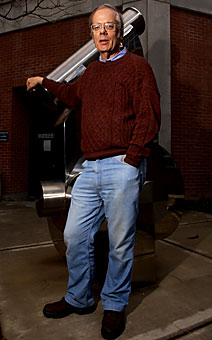 |
|
CHRIS CODUTO/Arizona Daily Wildcat
|
Roger Angel designs the next generation of telescopes. The Giant Magellan Telescope (GMT) is scheduled to be complete by 2015.
|
|
|
By J. Ferguson
Arizona Daily Wildcat
Tuesday, February 1, 2005
Print this
Plans for a new telescope are underway at the Steward Observatory, which will allow astronomers to see objects in space 10 times better than the Hubble Space Telescope.
A consortium of observatories and their academic partners have signed an agreement with the observatory to produce the first of seven 8.4 meter mirrors required to form the next generation of telescopes, the Giant Magellan Telescope.
The GMT will be used to research the birth of stars and planetary systems, the mysteries of black holes and the genesis of galaxies, said Matt Johns, project manager for the Magellan Project at Observatories of the Carnegie Institution of Washington.
Johns said the first mirror to be cast at the Steward Observatory Mirror Laboratory next summer was funded by the Giant Magellan Telescope Consortium.
The consortium, of which Carnegie Observatory is a lead partner, includes members from previous Magellan projects, including the Magellan I and Magellan II in Chile.
The consortium members also include the UA, Harvard University, the Massachusetts Institute of Technology, the Smithsonian Astrophysical Observatory and the University of Michigan.
Johns said the University of Texas at Austin and Texas A&M University, who were not part of previous Magellan projects, joined the consortium to help build and fund the GMT.
J. Roger P. Angel, mirror laboratory director and regents professor, said that when combined, the seven mirrors would be equivalent to a mirror of 21.4 meters. The finished product is expected to be complete in 2016.
With the help of adaptive optics and correction for atmospheric blurring, the GMT will take more accurate images at a farther distance than other telescopes.
Angel said the GMT is a reaction to a decadal survey by the National Academy of Sciences' astronomy, which concluded there was a need for extremely large ground-based telescopes.
The GMT is not the only extremely large telescope planned, as a competing design called the California Extremely Large Telescope is vying for future funds.
A collaboration of the University of California and the California Institute of Technology has proposed the 30-meter CELT.
Angel said while there is plenty of private funding available for both proposed telescopes, they might be vying for funding from the National Science Foundation and the National Academy of Sciences.
Johns said the funds to pay for the first mirror cast at the mirror lab came from a combination of private sources and the universities that belong to the GMTC.
